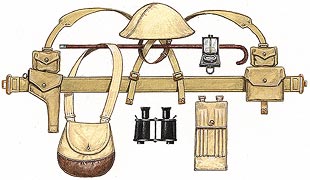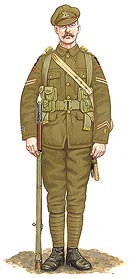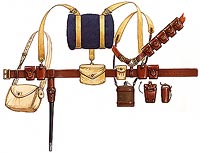The First World War 1914-1918
The Queen's (Royal West Surrey) Regiment

 |
| Corporal of The Queen's in Service Dress, 1916, 7th Division. |
The Queen’s (Royal West Surrey) Regiment paid a high price for its commitment in the First World War; 8000 men were killed out of the twenty-five battalions/thirty-one units formed and The Regiment gained five Victoria Crosses (VCs). In the 1st Battalion alone, five commanding officers, two majors, sixty-one company officers and 1,133 NCOs and men were killed in action. (Each battalion was about one thousand strong and was organised into an Headquarters Company and four rifle companies).
The Regular Battalions
The first battalions to see action in the First World War were
the Regulars. The 1st Battalion arrived in France in 1914, as
part of the 3rd Brigade, 1st Division. The 2nd Battalion joined
the British Expeditionary Force in September 1914 and joined the
22nd Brigade of the 7th Division. The scale of casualties in both
battalions was horrific; by the end of the first week of November
1914 there were only thirty-two survivors out of a total of 998
men from the 1st Battalion. The 2nd Battalion had suffered 676
casualties. Their ranks were to be filled by Territorials, men
from Kitchener’s “New Army” and then Conscripts.
The 1st Battalion fought at Mons, on the Marne and the Aisne, Ypres, the Aubers Ridge, Loos on the Somme, Festubert, The Hindenburg Line, Bellecourt, Broodseinde, Passchendaele and Arras. When it came out of the line in November 1918, only seventeen men were left out of the all ranks, who had gone to France in 1914.
The 2nd Battalion fought at Ypres, Aubers Ridge, Festubert, Loos and the Somme. In 1917, it was sent to Italy with the 7th Division, where it added to its honours at Piave and Vittoria Veneto.
 |
| Bandolier equipment, 1903. |
The Territorial Force Battalions
The Territorial Force Battalions also contributed greatly to the
war effort. Among the several battalions of the Queen’s
were the 1/4th and 1/5th of the Home Counties Division, which
was sent to India and the 2/4th, which as part of the 53rd Division,
fought at Gallipoli and Gaza and reached Jerusalem in 1917. This
battalion then moved to France to fight on the Marne and join
in the final offensive. The 3/4th went to France in 1917 and in
its first engagement lost nearly half its strength. The 1/5th went from India to Mesopotamia and the 6th went to France in 1915
and fought at Loos, the Somme, Arras and Cambrai.
The Service Battalions
The 6th, 7th, 8th, 10th and 11th Service Battalions were made
up of mainly Kitchener Volunteers. All of them served on the Western
Front with distinction. The 7th went to France in 1915 and suffered
appalling casualties on the Somme, at Ypres and at Amiens. The
8th lost heavily on the Western Front, particularly at the Somme
and in the Third Battle of Ypres. The 10th and 11th were both
with the 41st Division in 1916 and were decimated at Fleurs, but
later contributed to the campaign in Italy.
